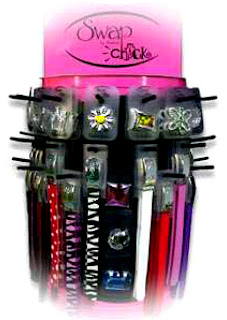Fourth Circuit Upholds District Court Affirmance of TTAB Dismissal of SWATCH Opposition versus SWAP
The U.S. Court of Appeals for the Fourth Circuit has affirmed the decision of the U.S. District Court for the Eastern District of Virginia [TTABlogged here], which upheld the Board's decision in the SWATCH v. SWAP opposition [TTABlogged here]. The Board dismissed Swatch's opposition to registration of the mark SWAP ( in stylized form) for "watch faces, ribbon watch bands, slide pendants, and beaded watch bands," finding it not merely descriptive of the goods, and not likely to cause confusion with or to dilute the registered mark SWATCH for watches, clocks, and parts. The district court entered judgment against Swatch on its six litigation claims: for reversal of the TTAB decision, and for federal and state trademark infringement and unfair competition, and federal dilution. In a 26-page opinion, the Fourth Circuit agreed with the district court. Swatch AG v. Beehive Wholesale, L.L.C., 109 USPQ2d 1291 (4th Cir. 2014).

The appellate court disagreed with the district court with regard to the standard of review. The district court stated that in a Section 1071(b) proceeding it sits in a "dual capacity," applying a "unique standard of review," acting in part as an appellate body (reviewing facts found by the TTAB under the substantial evidence standard) and partly as a trial court (considering de novo the new evidence submitted). The appellate court asserted that this approach is "in tension with the statute and directly conflicts with the requirement of Kappos v. Hyatt, 132 S. Ct. 1690 (2012)." [Kappos interpreted "Section 1071(b)'s parent parallel, 35 U.S.C. Section 145"]
In sum, where new evidence is submitted, de novo review of the entire record is required because the district court "cannot meaningfully defer to the PTO's factual findings if the PTO considered a different set of facts."
However, it was not clear that the district court did improperly defer to the TTAB's factual findings, and so remand of the case to the district court was not necessary. "Although the district court stated that it would apply an impermissible hybrid review to its likelihood of confusion and strength-of-the-mark analysis, there are more than sufficient facts recited in the opinion to support its findings." Likewise as to the issue of mere descriptiveness, "even if the district court considered only the new evidence de novo, it found facts sufficient to support its finding that SWAP is not merely descriptive."
With regard to likelihood of confusion, the appellate court ruled that the district court "properly found, on a sufficient review of the entire record, that despite the fame of SWATCH and the similarity of the goods, the 'lack of similarity between the marks, lack of predatory intent, lack of similar advertising and only minimal similarity in facilities,' in combination with 'the most significant factor, actual confusion,' resulted in no likelihood of confusion between SWATCH and SWAP."
With regard to likelihood of dilution, the TTAB did not decide that issue on the merits, so the district court's review was de novo. [Actually, the Board denied the claim because Swatch did not prove fame for Section 2(d) purposes, let alone for dilution - ed.]. The district court found that Swatch had not shown that any similarity between the marks would impair the distinctiveness of the SWATCH mark. The appellate court again pointed out that the marks are not confusingly similar and furthermore there was no evidence of copying, and so it affirmed the lower court's dismissal of this claim.
Finally, the district court dismissed the trademark infringement and unfair competition claims. Both the Lanham Act and Virginia statutory and common law require a likelihood of confusion to establish such claims. Therefore, these claims failed.
Read comments and post your comment here.
TTABlog note: The appellate court also ruled that the issue of likelihood of dilution, like likelihood of confusion, is reviewed under a clear error standard, since both are fact-intensive inquiries.
Text Copyright John L. Welch 2014.




0 Comments:
Post a Comment
<< Home